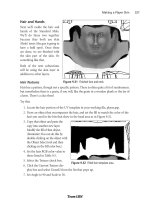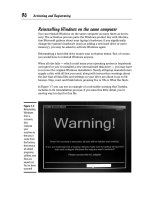all in one electronics guide pdf
Bạn đang xem bản rút gọn của tài liệu. Xem và tải ngay bản đầy đủ của tài liệu tại đây (26.46 MB, 464 trang )
All-in-OneElectronicsGuide
Acomprehensiveelectronicsoverviewforelectronicsengineers,technicians,students,
educators,hobbyists,andanyoneelsewhowantstolearnaboutelectronics
www.TechnicalBooksPDF.com
Yourcompletepracticalguidetounderstandingandutilizing
modernelectronics!
By:CammenChan
C&CGroupofCompaniesLLC.PublishedbyC&C
GroupofCompaniesLLC.Copyright2015.Allrights
reserved.
Nopartofthispublicationmaybereproduced,storedinaretrievalsystem,ortransmitted
inanyformorbyanymeans,electronic,mechanical,photocopying,recording,or
otherwise,withoutthepriorwrittenpermissionofthepublisher.
Website:
E-mail:
Facebook: />Twitter: />Alltrademarksmentionedhereinarepropertyoftheirrespectivecompanies.
BookCoverEditor:FloraGillis
BookEditor:PriscillaP.Flores
BookCoverDesigner:KristinFleming />ISBN-10:1479117374ISBN-13:978-1479117376PrintedintheUnitedStatesof
America
III
www.TechnicalBooksPDF.com
AbouttheAuthor
CammenChanhasbeenworkingintheelectronicsindustrysince1996.Afterreceiving
hisbachelorofsciencedegreeinelectronicengineeringtechnologyfromtheWentworth
InstituteofTechnologyandmasterofsciencedegreeinelectricalengineeringfromBoston
University,hebeganhisengineeringcareeratIBMMicroelectronics,thenworkedat
AnalogDevicesInc.,NationalSemiconductor,andseveraltechnologystartups.Hehas
oneUSpatentinventionintheareaofnanotechnology.Since2009,Cammenhasalso
beenanadjunctfacultymemberatanumberofUScollegesanduniversitiesincludingITT
TechnicalInstitute,DeVryUniversity,WesternInternationalUniversity,Universityof
AdvancingTechnology,ChandlerGilbertCommunityCollege,RemingtonCollege,and
ExcelsiorCollege.Heteacheselectronicsengineeringtechnology,informationtechnology,
mathematics,andemergingtechnologies.Cammenhastaughtallthesubjectsinthisbook
invariousformatssuchason-site,online,andblendedclasses.Currently,Cammenisa
technicaltrainingengineeratMicrochipTechnologyinthePhoenixarea.
IV
www.TechnicalBooksPDF.com
Introduction
Thesemiconductorindustryisabigbusiness.Theelectronicsindustryisevenbigger.The
semiconductorindustryalonewasaUS$300billionplusindustryin2012.Thelong-term
trendofelectronicsisbrightandpromising.Withincreasinguseofelectronicdevicesin
consumer,commercial,andindustrialproductsandsystems,theelectronicsindustryis
alwaysgrowing.Ifyouareconsideringbecominganelectronicsengineer,thisbookgives
youthetechnicalskillsneededto“pass”thetechnicalpartsofinterviewsandthe
confidencetoincreaseyourchancesofgettingemployed.Ifyouarealreadyanelectronics
technicianorengineer,thisbookimprovesyourabilitytoperformatthehighestlevelat
workintheelectronicsfield.Ifyouwanttobeamicroelectronicsengineerorarealready
one,youwillfindthemicroelectronics-relatedcontentsinthisbookapplicabletoyour
work.Ifyouareaneducatorteachingelectronics,thisbookistheperfectreferenceforyou
andyourstudentswithstep-by-steptechnicalexamplesandquizzes.Ifyouarean
electronicshobbyist,thisbookofferssampledelectroniccircuits(electroniccomponents
connectedwitheachotherbywiresortraces)youcanapplytoyourdesign.Foreveryone
elseinterestedinlearningaboutelectronics,thisbookprovidesastrongfoundationof
whatyouneedtoknowwhenworkingwithelectronics.
Thechaptersaredividedintovariouselectronicprincipleslevels,frombasictoadvanced,
alongwithpracticalcircuitsandquizzes.Answersprovidestep-by-stepexplanationsof
howandwhytheanswerswerederived.Examplesandcircuitsinlaterchaptersbuildupon
previouschapters,thuscreatingaconsistentflowoflearningandagradualaccumulation
ofknowledge.Thelevelofmathematicsismoderatewithouttediousandcomplicated
mathmodelsandformulas.Forstudentsmajoringinelectricalengineering,thisbookis
morethanyourtypicalacademicelectronicstextbookthatoverwhelmsyouwithexcessive
theories,formulas,andequations.Instead,thematerialcoveredinthisbookiseasyto
read,withplentyofdiagrams,pictures,waveforms,andgraphs,andiseasytounderstand.
Accuratelyrepresentingournon-idealworld,thisbook’stechnicalcontentsgreatlydiffer
frommostacademictextbooks’false“ideal”perspective.Thecontentisinjectedwithreal
worldquantitiesandcharacteristics.Forexperiencedelectronicsprofessionals,educators,
andhobbyists,thisbookaffordsagoodrealitycheckandcomprehensivereviewtoassist
yourcareeroryourstudents,tobetterprepareforyournextjobinterview,andtoinspire
yournextelectronicsprojects.
V
www.TechnicalBooksPDF.com
HowThisBookIsOrganized
Chapter1:DirectCurrent(DC)
First,learndirectcurrent(DC)theories.Then,applytheminpracticalcircuits.Basic
electricalparameters,concepts,andtheoriesarecovered.Thischaptercloseswith
practicalDCcircuits.
Chapter2:Diodes
Zeroinondiode,thebuildingblockoftransistors.Thischapterexplainsnotonlywhata
diodeismadeofbutalsotherealworldcharacteristicsofdiodeandsomepracticaldiode
circuits.
Chapter3:AlternatingCurrent(AC)
AftercomprehendingDCanddiodes,learnaboutAC,anothercriticalelectronicsconcept.
Fromhigh-powerelectricplantstocomputersandwirelesscommunications,AC
operationstakeplaceincountlesselectronicsystems.GetagoodholdonACdefinitions,
commonACparameters,capacitors,inductors,andsimpleACcircuits.
Chapter4:AnalogElectronics
Analogelectronicsuseasubstantialamountofanalogquantities.Transistorsand
operationalamplifiers(op-amp)arethebuildingblocksofmainstreamelectroniccircuits
andsystems.BipolarandComplimentary-Metal-Oxide-Semiconductor(CMOS)arethe
mostcommontypesoftransistors.Bipolartransistorsconsistoftwodiodes.Ontheother
hand,CMOSdoesnotcontainanyactivediodes.Althoughgermanium,gallium,and
arsenidecanbeusedtobuildtransistors,bothbipolarandCMOStransistorsprimarilyuse
siliconastherawmaterial.Performancedifferencesbetweenrawmaterialstypesmustbe
consideredtochoosethecorrecttransistortype.CMOSandbipolartransistorshave
similarvoltageandcurrentcharacteristicswithmajordifferencesinfundamental
operation.Asolidunderstandingofthesedifferencesisessentialforanalyzingand
designingtransistorsandop-ampcircuits.
Chapter5:DigitalElectronics
Basicdigitalelectronicsrequireanin-depthunderstandingofdigitalquantities,high(1)
andlow(0)logiclevel,logicgates,andcircuits.Itisconsiderablythebestsemiconductor
technologychoiceforhigh-speeddesignandoperations.Incomparisontoanalog
quantities,thesimpletwolevels(1and0)offerdistinctadvantagesoveranalog
technologysuchaslowernoise.Forcostreasons,digitalelectronicspresentagoodcase
forusingCMOStransistortechnologyindigitalsystems.CMOStransistorsaremadein
deepsub-microscopicscalewithadvancedchipmanufacturingcapability,while
manufacturingthroughputscontinuestoincreaseexorbitantly.Forhighspeed,highwww.TechnicalBooksPDF.com
densitydigitaldesignssuchasApplicationSpecificIntegratedCircuit(ASIC),Field
ProgrammableGateArray(FPGA),ormicroprocessors,digitaldesignersoftenuse
softwaretowriteprograms/codeforgeneratingCMOSdesign.UsingVHDLorVerilog,
instead
VIHowThisBookIsOrganized
ofmanuallyplacingtransistorsindividuallyinschematicsasinanalogdesign,digital
circuitsaregeneratedtorepresentthefunctionalandbehavioralmodelsandoperationsof
thetargetCMOSdesign.Inrecentyears,BiCMOSprocesshasgainedpopularity.Asits
nameimplies,thisprocesscombinesbothbipolarandCMOSdevices,offeringthebestof
both.
Chapter6:Communications
Electroniccommunicationsaretechnology.Itisanenormousbusinesses.Radios,cell
phones,homeandbusinesscomputersconnectedtotheinternetbyusingeitherwiredor
wirelessconnectionsarejustsomeexamples.Thevastmajorityofthistechnologyisonly
possibleduetotheadvanceddevelopmentofelectroniccommunicationsystems.
Additionally,amplitudemodulation,frequencymodulation,andphaselockedloopswill
bediscussedinthischapter.Understandingbasiccommunicationtheories,techniques,and
parameterswillgreatlyassistyourworkinthecommunicationsengineeringfield.the
foundationofwiredindustrywithitsmarketandwirelesscommunications
coveringbothconsumersand
Chapter7:Microcontrollers
Microcontrollersiliconchipshavefoundtheirwayintoavarietyofelectronicproducts.
Oneautomobilealonehasanaverageofeightymicrocontrollerscontrollingtheengine,
steeringwheelcontrols,GPS,audiosystems,powerseats,andothers.Microcontrollersare
embeddedinmanyconsumerandindustrialelectronicsincludingpersonalcomputers,TV
sets,homeappliances,children’stoys,motorcontrol,securitysystems,andmanymore.
Thefinalproductsthatusemicrocontrollersareembeddedsystems.Thesedevicesare
fieldprogrammable:theyallowsystemdesignerstoprogramthechiptotheneedsofa
specificapplication,whilelettingendusersperformalimitedamountofmodification.For
example,anenduserturningonamicrowaveovenisactually“programming”thetimer.
However,theenduserdoesnothaveaccesstothesourcecodeonthemicrocontroller,
hencethename“embeddedsystems.”Moreover,thesamemicrocontrollercanbeusedin
multipledesigns.Forinstance,dishwashersandrefrigeratorsusethesamemicrocontroller
witheachdesignhavingitsownspecificcodedownloadedtothemicrocontroller,
resultingintwocompletelydifferentapplications.Themicrocontroller’sfield
programmingcapabilitiesallowsmanyapplicationstobedesignedataverylowcost.
Comprehendingmicrocontrollerarchitectureandbasicprogrammingtechniqueswill
prepareyoutoexcelinthisfield.
www.TechnicalBooksPDF.com
Chapter8:ProgrammableLogicControllers
ProgrammableLogicControllers(PLCs)arewidelyusedinapplications.Thus,itis
worthwhiletostudytheminadditiontoconsumer-basedsystems.TypesandusesofPLCs
arecoveredfirst,followedbyaninsidelookatPLCs.Ladderlogicprogramming,a
graphicalprogrammingtechnique,istheheartofPLCs.Inaddition,afterexploring
practicalPLCprogramsandapplications,thechaptercloseswithPLCstroubleshooting
techniquesandfuturedevelopment.
HowThisBookIsOrganizedVII
industrialandcommercial
Chapter9:MentalMath
Ifyouhavetouseacalculatortosolve1/1k=1m,youareprobablynotmakingagood
impressiononinterviewersorevencoworkers.Usingmentalmathtodeciphersimple
arithmeticanswersdemonstratessolidmathematic,analytic,andproblemsolving
capabilities.Youcanlearnsimpletechniquestoimproveyourmentalmathabilityfor
calculatingelectronicsarithmetic.
Chapter1:DirectCurrent(DC)______________________________-1
Current
________________________________________________________________________
-1Resistor
________________________________________________________________________
-1Voltage
________________________________________________________________________
-5
Definition______________________________________________________________________
-5Ohm’s
Law______________________________________________________________________
-6Power
_________________________________________________________________________
-7VoltageSourceandSchematic
______________________________________________________-7CurrentSource
andSchematics_____________________________________________________-8
Electrons
_______________________________________________________________________8Currentversus
Electrons___________________________________________________________-9
Kirchhoff’sVoltageLaw(KVL)
______________________________________________________-9Kirchhoff’s
CurrentLaw(KCL)______________________________________________________11ParallelCircuit
www.TechnicalBooksPDF.com
__________________________________________________________________-11
ParallelResistorRule
____________________________________________________________-12Series
Resistor
Rule______________________________________________________________-13
CurrentDividerRule
_____________________________________________________________-15Voltage
Divider_________________________________________________________________
-16Superposition
Theorems__________________________________________________________-19
DCCircuits
_____________________________________________________________________-22
ICPackages
____________________________________________________________________-24
Summary
______________________________________________________________________33Quiz
__________________________________________________________________________
-33
Chapter2:Diodes_______________________________________-37
P-N
Junctions___________________________________________________________________
-37Forward-BiasedandReverse-Biased
________________________________________________-40DiodeI-VCurve
_________________________________________________________________-42
XTableofContents
DiodeCircuits
__________________________________________________________________-43
Summary
______________________________________________________________________47Quiz
__________________________________________________________________________
-48
Chapter3:AlternatingCurrent(AC)_________________________-49
SineWave
_____________________________________________________________________-49
FrequencyandTime
_____________________________________________________________-50Peak
Voltagevs.Peak-to-PeakVoltage
______________________________________________-52DutyCycle
_____________________________________________________________________-52
www.TechnicalBooksPDF.com
Vrms
_________________________________________________________________________
-54Impedance,Resistance,and
Reactance______________________________________________-54Capacitors
_____________________________________________________________________-55
XCversus
Frequency_____________________________________________________________56SimpleCapacitorCircuit
__________________________________________________________-57I(∆t)=C
(∆V)___________________________________________________________________59CapacitorChargingandDischarging
Circuit___________________________________________-60ParallelCapacitor
Rule___________________________________________________________-63
SeriesCapacitorRule
____________________________________________________________-63Power
RatioindB
_______________________________________________________________-64RC
SeriesCircuit
________________________________________________________________-64
–20dBperDecade
______________________________________________________________-65LowPassFilter
_________________________________________________________________-68
PhaseShift
____________________________________________________________________-69
Radian
________________________________________________________________________
-70ICE
___________________________________________________________________________
-71Inductors
______________________________________________________________________73XLversusFrequency
_____________________________________________________________-74V(∆t)=
L(∆I)___________________________________________________________________
-75ELI
___________________________________________________________________________
-77QFactor
_______________________________________________________________________77ParallelInductorRule
____________________________________________________________-78Series
InductorRule
_____________________________________________________________-79HighPassFilter
_________________________________________________________________-80
RealLandC
____________________________________________________________________-83
www.TechnicalBooksPDF.com
PracticalACCircuits
_____________________________________________________________-85Ringing
andBounce_____________________________________________________________
-86Inductive
Load__________________________________________________________________87DiodeClamp
___________________________________________________________________-88
SeriesRLC
Circuit_______________________________________________________________89LRCParallel(Tank)
Circuit_________________________________________________________-91
Transformers__________________________________________________________________
-93Half-Wave
Rectifier______________________________________________________________95SwitchingversusLinearRegulators
_________________________________________________-97BuckRegulator
_________________________________________________________________-97
Summary
_____________________________________________________________________100Quiz
_________________________________________________________________________
-101
Chapter4:AnalogElectronics____________________________-105
WhatIsAnalog?
_______________________________________________________________-105
AnalogICMarket
______________________________________________________________-106What
AreTransistorsMadeOf?
___________________________________________________-107NPNand
PNP__________________________________________________________________108NPNandPNPSymbols
__________________________________________________________-109Transistor
Cross-Section_________________________________________________________110BipolarTransistorTerminal
Impedance_____________________________________________-111IC,IB,IE,and
Beta(β)___________________________________________________________-111
XIITableofContents
VBE
_________________________________________________________________________
-113IE=IC+IB
____________________________________________________________________-113
ICversusVCECurve
www.TechnicalBooksPDF.com
____________________________________________________________-114
CommonEmitterAmplifier
______________________________________________________-115Common
CollectorAmplifier(EmitterFollower)______________________________________118CommonBase
Amplifier_________________________________________________________-120
Single-EndedAmplifierTopologiesSummary
________________________________________-121Tranconductance(Gm),SmallSignalModels________________________________________-121Common
EmitterAmplifierInputImpedance________________________________________123CommonEmitterAmplifierOutputImpedance
______________________________________-124CommonCollectorAmplifier
Small-SignalModel_____________________________________-127CommonBase
AmplifierSmall-SignalModel________________________________________-128
Single-EndedAmplifierSummary
_________________________________________________-129NMOSandPMOS
______________________________________________________________-1303D
NFET
______________________________________________________________________131DrainCurrentandThresholdVoltage
______________________________________________-132NFETandPFET
Symbols_________________________________________________________-132IC
Layout
_____________________________________________________________________134VHDLandVerilog
______________________________________________________________-135
MOSFETCrossSectionandOperations
_____________________________________________-136MOSFETOn-Off
Requirements____________________________________________________-137ID
versusVDSCurve
____________________________________________________________-139CMOS
SourceAmplifier_________________________________________________________
-139MOSFETParasitic
______________________________________________________________-142
CommonDrainAmplifier(SourceFollower)
_________________________________________-143CommonGate
Amplifier_________________________________________________________-145
BipolarversusCMOS
___________________________________________________________-147
DifferentialAmplifiers
__________________________________________________________-148
TableofContentsXIII
CommonMode
________________________________________________________________-149
www.TechnicalBooksPDF.com
CMRRandDifferentialGain
______________________________________________________-150Current
Mirror_________________________________________________________________152Op-Amp
______________________________________________________________________153Op-AmpRules
_________________________________________________________________-155
InvertingAmplifier
_____________________________________________________________-158NonInvertingAmplifier
_________________________________________________________-160Op-Amp
Parameters____________________________________________________________162LM741
_______________________________________________________________________164CurrentMirrorInaccuracies
______________________________________________________-165WilsonCurrent
Mirror__________________________________________________________-166
Bipolar
Cascode________________________________________________________________167DarlingtonPair
________________________________________________________________-168
CMOSCacosde
________________________________________________________________-170
Buffer(VoltageFollower)
________________________________________________________-171Summing
Amplifier_____________________________________________________________172ActiveLow-PassFilter
___________________________________________________________-174Circuit
Simulator_______________________________________________________________
-176Hysteresis
____________________________________________________________________-179
PositiveFeedback(Oscillation)
___________________________________________________-182Instrumentation
Amplifier_______________________________________________________-184
LinearRegulator
_______________________________________________________________-185Low
Drop-out(LDO)Regulator
____________________________________________________-186Summary
_____________________________________________________________________189Quiz
_________________________________________________________________________
-190
Chapter5:DigitalElectronics_____________________________-195
1sand0s:TheInverter
www.TechnicalBooksPDF.com
__________________________________________________________-196NMOS
Inverter________________________________________________________________
-197NFETandPFETInverter
_________________________________________________________-197Inverter
Action________________________________________________________________198Shoot-Through
Current__________________________________________________________-199
Ring
Oscillator_________________________________________________________________
-200ORLogicGate
_________________________________________________________________-202
ORGateSchematic
_____________________________________________________________-202ThreeInputOR
Gate____________________________________________________________-203
LSB,MSB
_____________________________________________________________________204NOR
Gate_____________________________________________________________________
-204ANDandNAND
Gates___________________________________________________________-205
XORGate
_____________________________________________________________________206CombinationalLogic
____________________________________________________________-206Boolean
Algebra_______________________________________________________________207Latch
________________________________________________________________________
-208FlipFlop______________________________________________________________________
-210DandJ-KFlipFlops_____________________________________________________________-211
Frequency
Divider______________________________________________________________211Shift
Register__________________________________________________________________
-213ParallelDataTransmission
_______________________________________________________-214Multiplexer
___________________________________________________________________-215
Mixed-signal
__________________________________________________________________-216
LevelShifter
__________________________________________________________________-217
Multi-Layer
Board______________________________________________________________-217
DigitalVoltageLevels
www.TechnicalBooksPDF.com
___________________________________________________________-219
TableofContentsXV
Analog-to-DigitalConverter
______________________________________________________-219Nyquist
Frequency_____________________________________________________________221ADCGainandOffsetErrors
______________________________________________________-222Digital-toAnalogConverter______________________________________________________224Binary-WeightedDAC
___________________________________________________________-225555Timer
____________________________________________________________________-226
Summary
_____________________________________________________________________230Quiz
_________________________________________________________________________
-230
Chapter6:Communications_____________________________-231
TimeversusFrequencyDomains
__________________________________________________-232Harmonics,
Distortion,andInter-modulation________________________________________234Modulation
___________________________________________________________________-236
BitRate,USB,andBaud
_________________________________________________________-236C=Fλ
_______________________________________________________________________237AmplitudeModulation
__________________________________________________________-238
ModulationIndexandBesselChart
________________________________________________-239AM
Transmitter________________________________________________________________
-240FrequencyModulation
__________________________________________________________-241Phase
LockLoop(PLL)
___________________________________________________________-242Summary
_____________________________________________________________________245Quiz
_________________________________________________________________________
-245
Chapter7:Microcontrollers_____________________________-247
www.TechnicalBooksPDF.com
MCU
Parameters_______________________________________________________________
-248HarvardArchitecture
___________________________________________________________-251Dataand
ProgramMemory______________________________________________________251MCUInstructions
______________________________________________________________-255
InstructionClock
_______________________________________________________________-257
InternalOscillator
______________________________________________________________-258
Interrupt
_____________________________________________________________________260SpecialFeatures
_______________________________________________________________-261
Development
Tools_____________________________________________________________-262
Debugger_____________________________________________________________________
-263DesignExample:
Comparator_____________________________________________________-265
DesignExample:Timer
__________________________________________________________-269Summary
_____________________________________________________________________271Quiz
_________________________________________________________________________
-271
Chapter8:ProgrammableLogicControllers_________________-273
History
_______________________________________________________________________273PLCBenefits
__________________________________________________________________-275
PLCComponents
_______________________________________________________________-276PLC
ProgrammingandLadderLogic
________________________________________________-278PLCProgramming
Example_______________________________________________________-283PLC
ProgrammingSyntax
________________________________________________________-286Timers
_______________________________________________________________________292On-Timer
_____________________________________________________________________293On-TimerApplication
___________________________________________________________-294OffTimer_____________________________________________________________________
www.TechnicalBooksPDF.com
-295Off-TimerApplication
___________________________________________________________-296Counter
______________________________________________________________________297CounterApplication
____________________________________________________________-298
ProgramControlInstructions
_____________________________________________________-300JumptoLabel
Instructions_______________________________________________________-300
JumptoSubroutineInstructions
__________________________________________________-301NestedSubroutines
____________________________________________________________-303
TableofContentsXVII
TemporaryEnd
________________________________________________________________-304
DataManipulationInstructions
___________________________________________________-304PLCData
Structure_____________________________________________________________305MOVInstruction
_______________________________________________________________-306
MOVInstructionApplication
_____________________________________________________-307DataCompare
Instructions_______________________________________________________-308
MathInstructions
______________________________________________________________-311
SequencerInstructions
__________________________________________________________-315Trends
_______________________________________________________________________317Summary
_____________________________________________________________________317Quiz
_________________________________________________________________________
-318
Chapter9:MentalMath________________________________-319
MultiplesandSubmultiplesofUnits
_______________________________________________-319DecimalNumbers
______________________________________________________________-320
WholeNumbers
_______________________________________________________________-320
MultiplesNumberConversion
____________________________________________________-320Submultiples
NumberConversion_________________________________________________-321
One-OverReciprocalwithMultiplesandSubmultiples
www.TechnicalBooksPDF.com
________________________________-323MultiplicationandDivisionwith
MultiplesandSubmultiples___________________________-325Percentageto
Decimals_________________________________________________________-326
LogtoRealNumber
____________________________________________________________-326
Summary
_____________________________________________________________________328Quiz
_________________________________________________________________________
-328
AbbreviationsandAcronyms____________________________-329Index
________________________________________________-335
www.TechnicalBooksPDF.com
Chapter1:DirectCurrent(DC)
StudentsmajoringinelectronicsalwaysstartwithaDirectCurrent(DC)class.DCisa
basicelectronictheorythatyoumustlearnandunderstandwell.Thisisthefirststeptoa
successfulcareerinelectronics.Let’sfirstdefinesomeDCparameters.
Current
Electricalcurrentisquantifiedaschange(∆ordelta)ofelectroncharge(Q)withtime.
Thinkofitasflowrateinplumbing.measureofcharges(∆Q)flowingthroughapoint
(node)withtime(seefigure1.0).Current’sunitisamperes(A)with“I”beingitssymbol.
Electricalcurrentisathenumberofelectron
Current=∆Q/TimeResistor
Allmaterialspossessresistance,whichisameasureoftheamountofresistorvalue.A
resistorisapassiveelectronicdevicemadeexclusivelyforelectronicsystems.Resistors
resistcurrentflowforagivenelectricalvoltage(voltagewillbedefinedshortly).A
passivedevicebydefinitiondoesnotgenerateenergybutratherstoresand/ordissipates
energy.Themostabundantmaterialsusedinresistorsarecopper(Cu)andaluminum(Al).
Carbon,thin-film,metalfilm,andwire-woundarepopularresistortypes.Resistorsize
(resistance)ismeasuredinunitOhms(Ω)with“R”asthesymbol.Resistorscomein
manyphysicalforms.Wire-leads,surface-mount,integratedcircuits(ICs)packageare
popularones.Figure1.1onthenextpageshowsagraphicalviewofacopper(Cu)wire
bundlewithacertainlengthandareaexhibitingafiniteresistanceamount.Internetwires
andcablesfoundinresidentialandcommercialdwellingsarelargelymadeofcopperwith
aplasticshieldontheoutside.Aresistorcanbediscrete(onedeviceperitem)or
manufacturedviaanICprocesshousedinanICpackage.Wewillexploremoreon
semiconductorpackageslaterinthechapter.Resistanceforagivenmaterialstrongly
dependsontheresistordimension,whereresistivityisuniquetothematerialstype:
www.TechnicalBooksPDF.com
Figure1.0:∆Q/time
Figure1.1:Copperwire
Commoncarbonresistorsaremeasuredintheorderofseveralcentimeters(seefigure
1.1a).
www.TechnicalBooksPDF.com
Figure1.1a:Carbonresistors
Duetothesmallcarbonresistorsizes,colorbandsareusedtoindicateresistancevalues
insteadofprintingthemontheresistors.Therearefourbands.Thefirstbandontheleft
representsthefirstsignificantresistancedigit.Thesecondbandisthesecondsignificant
digit.Thethirdbandisthemultiplier,andthelastistolerance.Tolerancedeterminesthe
maximumpercentagechangeinresistancefromitsnominalvalue.Table1-1showsthe
detailsamongbandcolor,digitvalues,multiplier,andtolerances.
www.TechnicalBooksPDF.com
Table1-1:Resistorbandcolor,digitvalues,multiplier,andtolerances
Let’sapplythistoanexample.Whatistheresistanceofthecarbonresistorthathas
Brown,Orange,Red,andGoldbands?First,brownyields“1”;orangemeansdigit“3”;
redmultipliermeans“100”;goldrepresents5%tolerance.Theresistanceistherefore
calculatedas:
13X100=1,300Ωor1.3kΩwith5%tolerance.
Figure1.1b:
Surface-mountresistor
www.TechnicalBooksPDF.com
Surface-mountresistors,ontheotherhand,arepopularduetotheirminiaturesizes.They
areidealforportableapplicationswhensmallsizeisnecessary.Figure1.1bshowsseveral
surface-mountresistors.Asurface-mountresistorcanbemeasuredassmallas0.2mm
(millimeter)X0.4mm(millimeter).Becausesurface-mountresistorsaresmall,inorderto
determinetheirvalues,numberingcodesareusedinsteadofcolorbands.Thenumbers
printedontheresistorareusually3-digitnumbers.
Thefirsttwonumbersrepresentthefirsttwodigitsoftheresistorvalueswhilethethird
digitrepresentsthenumberofzeros.Forexample,aresistormarkedwith203means20X
1,000Ωor20kΩ.A105resistorgives10X105Ωor1MΩ.Resistorsmanufacturedby
microelectronicstechnologyusedifferentmethodstodetermineresistances.Depending
uponthechipmanufacturingprocess,therecanbemultipleresistortypes,rangingfrom
metalandthin-filmtopolyresistors.Theresistancesaredeterminedbytheverticaland
horizontaldimensionsinconjunctionwiththesheetrho(pronouncedasrow)resistance.
Sheetrho’sunitsareinΩpersquare(Ω/square).Forexample,aBipolar-CMOS
(BiCMOS)processthin-filmresistor’ssheetrhoisspecifiedas1,000Ω/square.Length
/Widthdefinesthesquarenumbers.Iftheresistor’slengthandwidtharedrawnas10
micrometers(um)by10micrometer(um)respectively,thenumberofsquareequatesto10
um/10um=1.Theresistanceisthencalculatedas:
Regardingthechipmanufacturingprocess,inadditiontosheetrhoresistances,each
processoffersaslewofdeviceswithauniquesetofparameters.Belowaresomecommon
onesyouwilllikelyencounter.Transistors’minimumgeometries:CMOSusesgatelength
wherebipolartransistorsuseemitterwidth.Transistors’maximumoperatingfrequencies:
capacitors’capacitanceperunitarea;temperaturecoefficient(itdetermineshowmuch
variationsdeviceparameterchangeswithtemperature);maximumvoltagesupplyand
breakdownvoltages;transistors’drawnversusmanufactureddimensions,metallevel
numbersavailable,andmanymore.Furtherexplanationsoftheseparameterswillbe
discussedlaterinthisbook.Fullunderstandingoftheseparametersisnecessarybefore
decidingonaprocesstouseforaparticularchipdesign.Furtherdetailsonmicroelectronic
designwillalsobediscussedinlaterchapters.
Voltage
Voltageisthepotentialdifference(subtraction)betweentwopoints(nodes).Theobjectof
thesepointscanbeanymaterial.Themostcommonmaterialsareelectronicdevicessuch
asresistors,diodes,andtransistors,whicharethemainfocusofthisbook.Eachelectrical
parameterhasitsownsymbolandunit.Theyaresummarizedintable2-1.
www.TechnicalBooksPDF.com
Table2-1:
V,I,Rsymbols;units
Definition
Directcurrent(DC)statesthatelectricalcurrentflowsthrougharesistorwithoutchanges
inamplitudesorfrequencies.Awaveformcanbeusedtomakeclearsuchphenomenon.A
waveformisatime(transient)domaingraphthatshowsquantitiessuchasvoltage,
current,orpoweronthevertical(Y-axis);timeonthehorizontal(X-axis)(seefigure1.2).
Inthiswaveform,theDCvoltagelevelstaysthesameovertimewhilethefrequencyof
DCiszero.Wewillfurtherdefineamplitudeandfrequencyinchapter3,AC.
Figure1.2:Voltagevs.timeinDC
Ohm’sLaw
Ohm’slawstatesthatwhenthereisavoltagedeveloped(drop)acrossaresistor,i.e.,
voltagedifferencebetweentworesistorends(nodes),electricalcurrentisboundtoflow.
Themathematicalrelationshipbetweenvoltage(V),current(AorAmp),andresistance
www.TechnicalBooksPDF.com
(Ω):
Voltage=CurrentXResistance
Foragivenresistorsize,increasingvoltagecausescurrenttoincreaselinearly.Thereby,
Ohm’slawissimplyalinearfunction(seefigure1.3).Wecanapplytheabovelinear
relationshipamongvoltage,current,resistor,andslopeconcepttocalculateresistance.A
V-Igraphisshowninfigure1.4.Anytwopointscanbeusedtocalculateslope
(resistance).Becausethisisalinearfunction(straightline),slope(resistance)isfixed.
Resistorsareusuallyinlargesizes—thousandsofΩs,sometimesevenmore.Thisis
because,foragivenvoltage,largeresistanceresultsinlowercurrent(linearrelationship).
Thisisessentialduetosafetyandpower-savingreasons.UsingOhm’slaw,1Vdividedby
1Aequals1Ωresistance(1V/1A=1Ω).Oneampereisalotofcurrent,infact,current
above100mA(milliamp)goingthroughthehumanbodyisdeemedlethal.Tolowerthe
currentforagivenvoltageata
Figure1.3:Ohm’sLaw,
alineargraph
www.TechnicalBooksPDF.com









